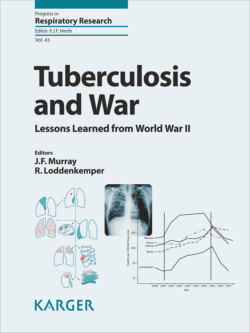Читать книгу Tuberculosis and War - Группа авторов - Страница 36
На сайте Литреса книга снята с продажи.
Transmission of Tubercle Bacilli
ОглавлениеThe extent to which M. tuberculosis is transmitted during a given period of time – the incidence of infection with M. tuberculosis – determines the subsequent incidence of TB (the disease). The latter determines TB fatality (the magnitude modified by chemotherapy) in the individual and thus TB mortality in the population. Because TB has no defined incubation period, the extent of transmission during a specified period of time also has long-term consequences as latent infection may progress to TB many years, even decades, after acquisition of infection. This is demonstrated in studies among untreated contacts (placebo-recipients in a preventive therapy trial) of newly diagnosed TB patients in the United States [5, 6]. The risk of progression was highest during the first 2 years following infection, and dropped to about one tenth of the initial annual risk in the subsequent years, but it never became zero as is the case with diseases that are characterized by a well-defined incubation period. Thus, the extent of transmission that occurs has both immediate and long-term implications for expected TB morbidity subsequent to acquisition of infection with M. tuberculosis.
Fig. 1. Model used in the discussion of the epidemiology of tuberculosis, based on the classification of tuberculosis by the American Thoracic Association and the Centers for Disease Control and Prevention. Adapted from [2, 3].
